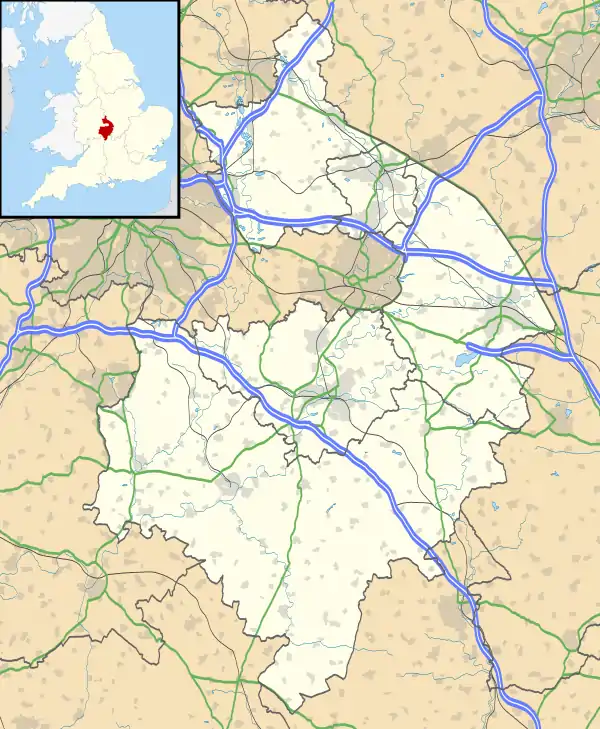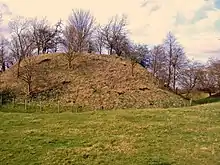Seckington
Seckington is a village and civil parish[2] in North Warwickshire, about 4 miles (6 km) northeast of Tamworth, Staffordshire. The B4593 road between Tamworth and Appleby Magna runs through the parish, passing about 100 yards (91 m) north of the village.
| Seckington | |
|---|---|
 All Saints' parish church, seen from the east | |
 Seckington Location within Warwickshire | |
| Population | 59 (2001 Census)[1] |
| OS grid reference | SK2607 |
| Civil parish |
|
| District | |
| Shire county | |
| Region | |
| Country | England |
| Sovereign state | United Kingdom |
| Post town | Tamworth |
| Postcode district | B79 |
| Dialling code | 01827 |
| Police | Warwickshire |
| Fire | Warwickshire |
| Ambulance | West Midlands |
| UK Parliament | |
Seckington shares a parish council with Newton Regis, Seckington and No Man's Heath.[3]
Early history
.jpg.webp)
In AD 757 King Æthelbald of Mercia was assassinated at Secandune[4] (Seckington).[5] Continuations of the Historia ecclesiastica gentis Anglorum say he "was treacherously and miserably murdered, in the night, by his own guards".[6]
The Domesday Book of 1086 records Secintone as a vill with a manor of five hides.[4]
Castle

Seckington Castle is a motte-and-bailey castle believed to have been built in the late 11th century for either Roger de Beaumont, Earl of Meulan or his son Robert de Beaumont, 1st Earl of Leicester.[7]
In the late 17th century the antiquary Sir William Dugdale (1605–86) described, measured and recorded the castle in detail.[7] Since 1923 the castle has been protected as a scheduled monument.[7]
The motte is now about 30 feet (9 m) high and its diameter is about 150 feet (46 m) at the base.[8] The bailey is south and east of the motte.[8]
The castle is surrounded on three sides by traces of ridge and furrow cultivation.[7]
Parish church
The Church of England parish church of All Saints is probably mid- to late-13th century in origin,[4][8] but was significantly altered in a late 19th-century Victorian restoration.[4]
The west tower and spire were rebuilt in 1883, re-using much of the original material.[4] The bell-openings are Early English, the ogeed west window is Decorated Gothic and the parapet and spire are Perpendicular Gothic.[8] The spire has two sets of lucarnes.[8]
The nave and chancel are Decorated Gothic[8] with 14th-century windows.[4] The chancel east window has five lights[4] and intersecting tracery, and is said to have been widened in the restoration.[4] There is extensive use of ogees. As well as in the west window of the nave, ogees feature in two south windows of the nave,[4] one south and two north doorways[8] and a double piscina in the chancel.[8]
All Saints had a rood screen and rood loft, traces of which are visible in the east wall of the nave on both sides of the chancel arch.[4] Outside, on the south wall of the nave east of the porch is a scratched mass dial.[4]
All Saints' church monuments include a defaced recumbent effigy of a lady in early 14th-century dress, and a Jacobean wall-mounted monument to Robert Burdett, who died in 1603.[4][8] He is an ancestor of the Burdett baronets of Bramcote. His monument is of veined marble, with Corinthian columns flanking kneeling figures of his family.[4]
The west tower has a ring of four bells.[9] Robert Mellours of Nottingham cast the treble bell in about 1520;[9] it is inscribed with the name IESUS.[4] Hugh II Watts of Leicester cast the tenor bell in about 1640.[9] John Taylor & Co of Loughborough cast or re-cast the second and third bells in 1886[9] for the rebuilt tower. The ring is unusual in that the third bell, not the tenor, has the largest diameter.[9]
All Saints has been a Grade II* listed building since 1953.[10]
All Saints is now part of the Benefice of All Souls, which also includes the former parishes of St Nicholas, Austrey; St Mary the Virgin, Newton Regis; St Matthew, Shuttington and Holy Trinity, Warton.[11]
Other listed buildings
Seckington has four Grade II listed buildings. Rock Farmhouse is partly 17th century, with late 18th century additions.[12] Old Hall Farmhouse is late 17th or early 18th century, with late 18th and early 19th century additions.[13] The Old Rectory was 18th century but was largely rebuilt in about 1870.[14] Church Farmhouse is late 18th or early 19th century.[15]
References
- "Parish Headcounts: Area selected: North Warwickshire". Neighbourhood Statistics. Office for National Statistics. Retrieved 4 June 2013.
- "Seckington". Mapit. Retrieved 21 January 2018.
- "Home". Newton Regis, Seckington and No Man's Heath Parish Council. Retrieved 21 January 2018.
- Salzman 1947, pp. 198–200
- Ellis 1994, p. 162.
- "CHAP. XXIV. Chronological recapitulation of the whole work: also concerning the author himself". Bede's Ecclesiastical History of England. Christian Classics Ethereal Library. Retrieved 4 June 2013.
- Historic England. "Motte and bailey castle, 90m NW of All Saints' Church (1011366)". National Heritage List for England. Retrieved 4 June 2013.
- Pevsner & Wedgwood 1966, p. 393
- Chester, Mike; Kelly, Dave (30 July 2009). "Seckington All Saints". Dove's Guide for Church Bell Ringers. Central Council of Church Bell Ringers. Retrieved 4 June 2013.
- Historic England. "Church of All Saints (1252599)". National Heritage List for England. Retrieved 4 June 2013.
- Archbishops' Council (2010). "Benefice of All Souls, North Warwickshire". A Church Near You. Church of England. Retrieved 4 June 2013.
- Historic England. "Rock Farmhouse (1262205)". National Heritage List for England. Retrieved 4 June 2013.
- Historic England. "Old Hall Farmhouse (1252598)". National Heritage List for England. Retrieved 4 June 2013.
- Historic England. "The Old Rectory (1262174)". National Heritage List for England. Retrieved 4 June 2013.
- Historic England. "Church Farmhouse (1252600)". National Heritage List for England. Retrieved 4 June 2013.
Sources
- Ellis, Peter Berresford (1994) [1993]. Celt and Saxon The Struggle for Britain AD 410–937. London: Constable & Co. p. 162. ISBN 0-09-473260-4.
- Pevsner, Nikolaus; Wedgwood, Alexandra (1966). Warwickshire. The Buildings of England. Harmondsworth: Penguin Books. p. 393.
- Salzman, LF, ed. (1947). A History of the County of Warwick, Volume 4: Hemlingford Hundred. Victoria County History. London. pp. 198–200.